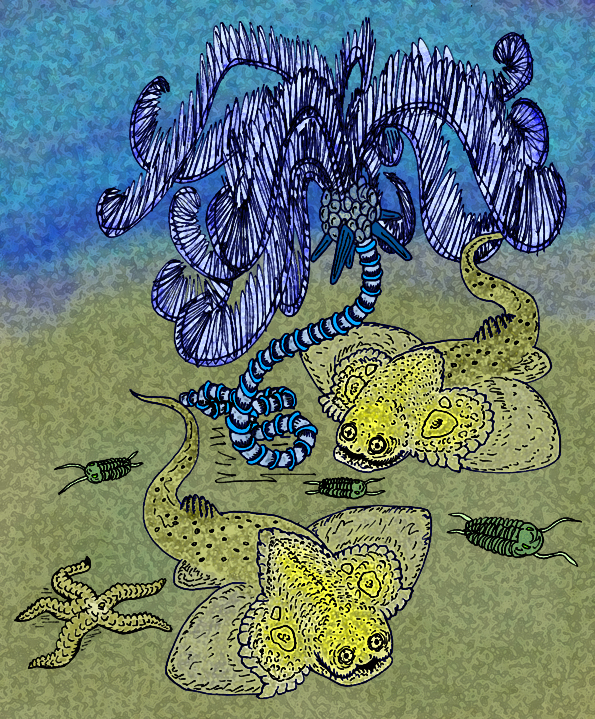- Gemuendina stuertzi
Taxobox
name = "Gemuendina"
fossil_range = EarlyDevonian
regnum =Animal ia
phylum =Chordata
classis =Placodermi
ordo =Rhenanida
familia =Asterosteidae
genus = "Gemuendina"
species = "G. stuertzi""Gemuendina stuertzi" ("Stuertz's Gemünden (fish)") was an early
placoderm species of the orderRhenanida , of the seas of EarlyDevonian Germany. "Gemuendina" resembled a scaly ray with a pair of staring eyes, a pug-nose, and an upturned mouth. This leads virtually all artists who reconstruct it to give the creature a quizzical, almost shocked expression. It is a good example ofconvergent evolution - with its flat body and huge,wing -likepectoral fin s it is highly similar to rays. Unlike rays, both "Gemuendina"`seye s andnostril s were placed atop the head. Unlike most other placoderms, such as the Antiarchs, or the Arthrodires, "Gemuendina" and its three other known relatives (six, if the species of "Ohioaspis " are considered to be rhenanids) had armor made up of a mosaic of unfused bony plates. Because their armor was so fragile, few examples of rhenanids have survived in thefossil record . Because several regions of theHunsruck lagerstätte were anoxic, thus free of scavenging organisms, intact, nearly pristine (albeit flattened) specimens of "G. stuertzi" have been found as a result. Also unlike other placoderms, it did not have the characteristic tooth plates of placoderms. Instead, it had star-shaped tubercle scales that allowed it to seize, then swallow fish and other animals that swam too close with its mouth.External links
* [http://www.palaeos.com/Vertebrates/Units/Unit060/060.100.html#Rhenanida "Paleos Rhenanida"]
References
* Janvier, Philippe. "Early Vertebrates" Oxford, New York: Oxford University Press, 1998. ISBN 0-19-854047-7
* Long, John A. "The Rise of Fishes: 500 Million Years of Evolution" Baltimore: The Johns Hopkins University Press, 1996. ISBN 0-8018-5438-5
Wikimedia Foundation. 2010.
